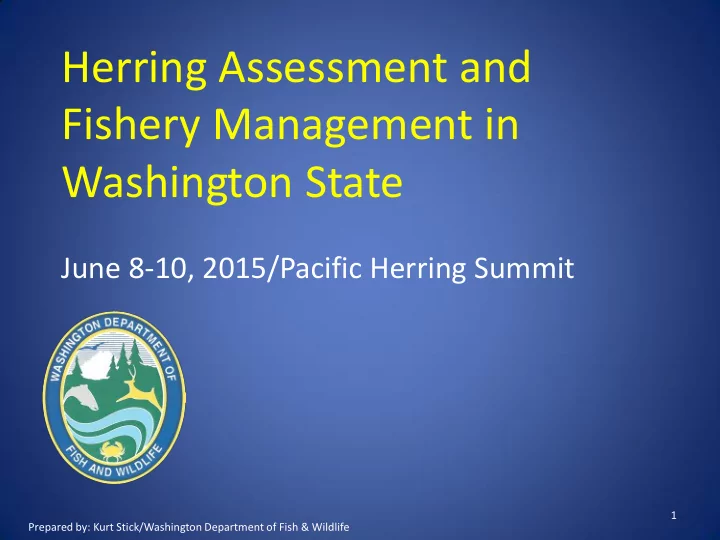

Herring Assessment and Fishery Management in Washington State June 8-10, 2015/Pacific Herring Summit 1 Prepared by: Kurt Stick/Washington Department of Fish & Wildlife
2 Prepared by: Kurt Stick/Washington Department of Fish & Wildlife
Herring Stock Assessment Methods • WDF/WDFW has used spawn deposition and/or acoustic/trawl surveys since early 1970s. Currently only spawn deposition surveys conducted. – Spawn Deposition Surveys : 2-person crew in small boat using rake to grapple vegetation (Semi to biweekly; 2-5 hours/survey; 6-30+ surveys/stock/year); ongoing – 156 surveys in 2013, 171 in 2014, 160 in 2015 (planned). – Acoustic/Trawl Surveys : chartered trawl vessel (58’) with 2 -3 WDFW staff; acoustic vessel operated by 2 WDFW staff; 1-10+ surveys/stock/year; cut after 2009 season. 3 Prepared by: Kurt Stick/Washington Department of Fish & Wildlife
Spawn Deposition Surveys • The biomass of spawning adult herring is estimated from the sampled density and area of spawn deposition as outlined by Hourston et al (1972) and described by Trumble et al (1977) and Meyer and Adair (1978); same conversion factors used since 1976: 1. Aquatic vegetation in lower intertidal and upper subtidal is sampled via rake for presence of herring eggs. 2. Density of eggs per unit area of the surveyed vegetated zone is estimated. 3. Based on fecundity per unit body weight, eggs/unit area is converted to estimated tons of adult herring spawning escapement. 4 Prepared by: Kurt Stick/Washington Department of Fish & Wildlife
Spawn surveys: Assumptions/sources of error • Non-uniform spawn deposition and substrate distribution. • Spawn density estimation rather than quantification. • Conversion factor of 100 eggs/gram of adult fish. • 50:50 sex ratio. • Survey timing/frequency. • Egg mortality. 5 Prepared by: Kurt Stick/Washington Department of Fish & Wildlife
Acoustic/trawl Surveys • Nighttime surveys on concentrations of prespawning herring. Numerous references including Lemberg et al. (1988). • Produces real-time estimates of total fish abundance using computer interfaced echosounding equipment. • Since 1978, Biosonics model 101 (105 kHz) echosounder, Biosonics 120/121 echo integrator used. • Average density (kg/m 2 ) calculated for each acoustic transect; herring spawning biomass estimate based on average density extrapolated to survey surface area using trawl catch data. • Mid-water rope trawl used (10m tall x 15 m wide opening; 1 cm codend mesh). • Analyses of trawl biological samples provide stock indices such as age composition, survival rates, and recruitment. 6 Prepared by: Kurt Stick/Washington Department of Fish & Wildlife
Prepared by: Kurt Stick/Washington 7 Department of Fish & Wildlife
Surface 2/10/2004 Skagit Bay acoustic/trawl herring survey Heavy herring sign at 20-30 fathoms Bottom Bottom depth in Prepared by: Kurt Stick/Washington fathoms 8 Department of Fish & Wildlife
9 Prepared by: Kurt Stick/Washington Department of Fish & Wildlife
Acoustic/trawl Surveys: Assumptions/sources of error • Target strength scaling factor. • Survey timing/frequency. • Patchy fish distribution requires heavy sampling effort to ensure representativeness. • Mixed size distribution. • Gear (acoustic and net) selectivity. • Stock identification of fish holding in given area. 10 Prepared by: Kurt Stick/Washington Department of Fish & Wildlife
Suggested Future Assessment Needs: • Additional stock identification/genetic work. • Reinstate acoustic/trawl surveys using split beam system; update/improve target strength application. • Investigate application of stock/area specific fecundity and age composition data to spawn survey estimates. • Better define limits of spawning substrate for each stock based on vegetation mapping rather than standardized assumptions. 11 Prepared by: Kurt Stick/Washington Department of Fish & Wildlife
Overview: Puget Sound Herring Fisheries • Commercial fisheries active since late 1800s. • Annual landings have ranged from <50 to 6,500 metric tons. • Tribal co-management since 1974. • Sport bait fishery only active commercial fishery since 1996. Mean annual landings for last 10 years is 268 metric tons. – Targets juvenile fish from mixed stocks in central Puget Sound • Cherry Point stock harvest closed due to low stock size; no current “adult”/ spawner harvest. 12 Prepared by: Kurt Stick/Washington Department of Fish & Wildlife
13 Prepared by: Kurt Stick/Washington Department of Fish & Wildlife
Management Elements: • Maximum harvest level of ≤10%. • Allocation to users (50% tribal:50% non-tribal). • Co-management with tribes. • Limited entry of non-tribal fishers legislated in 1973 to prevent growth of harvest capacity. • Harvest limited to immature fish in areas not associated with pre-spawn holding or active spawning. 14 Prepared by: Kurt Stick/Washington Department of Fish & Wildlife
Sport Bait Fishery: • Fishing mainly in southern Puget Sound and Admiralty Inlet. • Timing/area/gear restrictions to minimize harvest of spawning/adult fish. Most of landings by lampara gear (max. length of 200’) May -September. • Maximum harvest guideline is 10% based on cumulative spawning biomass of central and south Puget Sound stocks. – Landings 3-5% of cumulative spawning biomass since 1996. 15 Prepared by: Kurt Stick/Washington Department of Fish & Wildlife
Recommend
More recommend